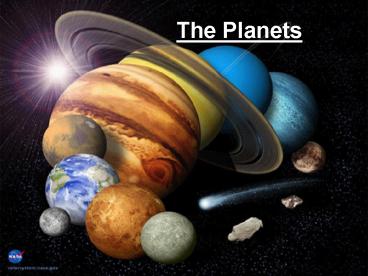The Planets PowerPoint PPT Presentation
1 / 17
Title: The Planets
1
The Planets
2
Discussing Planets
- Measure distances to planets in Astronomical
Units (AU). - 1 AU distance from Earth to the Sun 93
million miles. - Planets orbit elliptically around sun.
- Perihelion point closest to the sun
- Aphelion point farthest from the sun.
3
Discussing Planets, continued
- Orbit period the amount of time it takes the
planet to make ONE revolution around the sun (a
planets year). - Rate of Rotation how long it takes the planet to
rotate once around its own axis (a planets
day).
4
The Inner Planets Terrestrial Planets
- All are mostly solid rock with a metal core.
- Lighter elements have lower boiling points cant
condense this close to sun only rocks and metals
can. - Dense elements like iron are pulled by gravity to
center of planet during accretion (planet
formation) - No rings
- Surfaces have many impact craters caused by
collisions with rocky objects (asteroids).
5
Mercury
- Closest to sun
- Orbit period 88 days
- Rotates slowly on its axis one day is 59 Earth
days. - No moons
- Very, very thin atmosphere (planet is too small
to have enough gravity to hold gases) - Huge temperature range between day and night.
6
This image of Mercury passing in front of the sun
was captured Nov. 8, 2006 by the Solar Optical
Telescope, one of three primary instruments on
Hinode. Image credit Hinode JAXA/NASA/PPARC
7
Venus
- 2nd planet from sun.
- Orbit period 225 days.
- Also rotates slowly on axis one day is 243
Earth days. - Shows retrograde rotation rotates around its own
axis opposite of other planets. - Sun rises in west and sets in east!
- No moons.
8
Venus, continued
- Called Earths sister planet
- Has almost the same size, mass, and density.
- Very hot planet because of its thick atmosphere.
- Atmosphere is 96 Carbon Dioxide clouds, which
trap heat. - No liquid water rains sulfuric acid instead.
- Shows evidence of volcanic activity has rocks
and surface features (mountains, canyons, etc.)
similar to Earth.
9
Earth
- 3rd planet from Sun.
- Orbit period 365.24 days
- Rotation rate 23 hours, 56 minutes
- 5th largest planet in solar system has only one
moon. - Only planet in solar system with
- oceans of liquid water
- Proper combination of water, temperature, and
oxygen to support life.
10
Earth, continued
- Has moderate atmosphere of Nitrogen and Oxygen
gas, with small amounts of water vapor, carbon
dioxide, and other gases. - Tilted 23.5 degrees from the perpendicular North
Pole is always tilted toward North star. - The tilt of Earth causes seasons changes the
angle at which sun hits Earths surface. - N. Hemisphere toward sun summer, because days
are longer and we get more direct sunlight. - N. Hem. away from sun winter, longer days and
less direct sunlight.
11
Earths Moon
- 1/80th the size of Earth, with 1/6th the surface
gravity. - Shines because it reflects sunlight.
- Formed when a large, Mars-sized planetary body
collided with Earth early on in its formation. - Collision ejected Earth-like materials into
space orbited Earth and accreted
12
Earths Moon, continued
- No atmosphere wide temperature range
- Heavy cratering on Moon due to many asteroid
impacts. - Evidence of volcanic activity (old lava-filled
craters). - Craters and rocks are well preserved, (no wind,
weather, water, or ice to erode them). - The moon is responsible for
- Influencing ocean tides on Earth
- Stabilizing Earths rotation
- Gradually slowing Earths rotation through
friction. - In 1,000 years, the day will be 0.2 seconds
longer!
13
Eclipses
- Eclipse planetary body passes through the shadow
of another. - Umbra shadow where sunlight is completely
blocked. - Penumbra part of shadow where sunlight is
partially blocked.
14
- Solar eclipse moon passes between Earth and Sun
- Moons shadow blocks out sunlight in a small part
of the Earth. - Totally blocked (total eclipse) in the umbra.
- Partial eclipse in the penumbra.
- Lunar eclipse Earth passes between moon and sun,
preventing sunlight from reaching the moon.
15
Mars
- 4th planet from sun
- Orbit period 687 days
- Rotation 24 hours, 37 minutes
- Similar tilt in axis like Earth has seasons
- Has 2 moons, Phobos and Deimos
- Geologically active with large volcanoes (largest
in solar system!) - Little water is trapped in polar ice caps
- No real atmosphere
16
Olympus Mons largest volcano in solar system!
17
Mars Moons Phobos and Deimos
- May be the remains of one moon that was split by
an asteroid - Very small and irregularly shaped, not round like
our moon - Dark surfaces that are heavily cratered
- Craters indicated heavy bombardment by asteroids
- Very old

